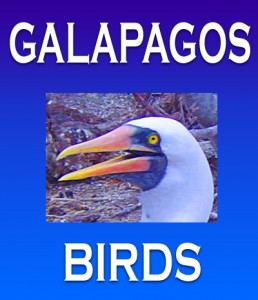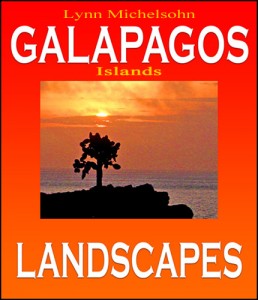Charles Darwin, Naturalist, visited Chatham Island (also called Isla San Cristobal) in the Galapagos Archipelego in 1835
Today . . .
Medium-sized San Cristobal (also known as Chatham Island), on the eastern edge of the archipelago, has the second largest population and number of developed tourist resources in the Galapagos Islands, after Isla Santa Cruz, with lots to see and do including snorkeling, scuba diving, and surfing.
Chatham Mockingbirds endemic to the island are plentiful throughout, as are opuntia cacti and poison-wood trees. Freshwater El Junco Lagoon is surrounded by endemic ferns and trees and home to many water birds. Sea lions an iguanas abound on the coast.
Several species of Frigate Birds nest on Frigate Bird Hill while all three species of Galapagos Boobies nest at Punta Pitt. Tortoises range freely nearby.
The administrative seat of the Galapagos Islands, the sleepy provincial capital of Puerto Baquerizo Moreno (named after the first Ecuadorian President to visit the islands in 1916) with several thousand inhabitants, sits on its western tip. The smaller of the archipelago’s two airports adjoins the town.
As one of the older islands, geologically, its volcanic features are weathered, most especially on the south-ern (windward, wet) side. Western slopes of Cerro San Joaqun, covered in native vegetation and agricultural lands, make up the southwestern half of the island. Typical volcanic landscape of the Galapagos covers the dryer northeastern half.
Uninhabited when the Beagle visited the islands, San Cristobal was first settled in 1837 by General Mena and a small group of settlers who fled the tyrannical leader of a colony on Floreana. This handful of settlers and their descendents hung on in the Puerto Baquerizo Moreno area for years.
About 1870 Manuel Cobos colonized the southwest highlands at El Progreso with a group of 100 convicts to grow sugar cane. Although initially successful as an agricultural colony, conditions began to deteriorate into brutality and ended in a murderous revolt in 1904. Today a village remains at the site as the second inhabited area on the island.
In 1835 . . .
Charles Darwin first set foot in the Galapagos on this island. The HMS Beagle made its first landfall in the Galapagos Islands on the southwest coast of Chatham Island—today called Isla San Cristobal. Captain Fitz-Roy and Darwin made an hour long tramp in the vicinity of today’s Frigatebird Hill or Cerro Tijeritas.
Darwin chose Chatham Island’s unattractive landscape for his initial comments after first setting foot on the islands that would henceforth be most closely associated with his name. While in his private Diary he described the country as “what we might imagine the cultivated parts of the Infernal regions to be,” he moderated his comments for publication. He wrote:
In the morning ([September] 17th) we landed Chatham Island, which, like the others, rises with a tame and rounded outline, broken here and there by scattered hillocks, the remains of former craters.
Nothing could be less inviting than the first appearance. A broken field of black basaltic lava, thrown into the most rugged waves, and crossed by great fissures, is everywhere covered by stunted, sunburnt brushwood, which shows little signs of life. The dry and parched surface, being heated by the noonday sun, gave to the air a close and sultry feeling, like that from a stove: we fancied even that the bushes smelt unpleasantly.
Although I diligently tried to collect as many plants as possible, I succeeded in getting very few; and such wretched-looking little weeds would have better become an arctic than an equatorial Flora. The brushwood appears, from a short distance, as leafless as our trees during winter; and it was some time before I discovered that not only almost every plant was now in full leaf, but that the greater number were in flower.
The commonest bush is one of the Euphorbiaceæ: an acacia and a great odd-looking cactus are the only trees which afford any shade. After the season of heavy rains, the islands are said to appear for a short time partially green. The volcanic island of Fernando Noronha, placed in many respects under nearly similar conditions, is the only other country where I have seen a vegetation at all like this of the Galapagos Islands.
Next, the Beagle stopped at Stephens Bay. Although Darwin chose to ignore this stop in his Journal, he noted in his Diary, “The Bay swarmed with animals; Fish, Shark & Turtles were popping their heads up in all parts.” When the crew began catching fish he noted, “This sport makes all hands very merry; loud laughter & the heavy flapping of the fish are heard on every side.” He must have diverted some of these from the dinner table, as almost all of the specimens in his fish collection came from this bay, according to naturalists Thalia Grant and Gregory Estes in Darwin in Galapagos.
In his Diary at this point Darwin called the islands “paradises for the whole family of Reptiles” mentioning the presence of three kinds of turtles, the abundant tortoises, and the marine iguanas he described as “large (2–3 ft) most disgusting, clumsy Lizards. . . black as the porous rocks over which they crawl . . . Somebody calls them ‘imps of darkness.’”
He also described his efforts to “botanize” at this location collecting ten different flowers, “but such insignificant, ugly little flowers” he thought them unworthy of the tropics.
Here he first noted the tameness of the birds in his Diary saying “Little birds within 3 & four feet, quietly hopped about the Bushes & were not frightened by stones being thrown at them.” The ship’s artist killed one with his hat while Darwin pushed a large hawk off a branch with the barrel of his gun.
At the next anchorage (today’s Bahia Tortuga de Agua Dulce, although there are no longer any “tortugas” there) Captain Fitz-Roy sent men ashore to hunt tortoises. These became the first giant tortoises that Darwin had seen, or tasted.
Once again Darwin ignored this stop in his published account but described the volcanic cone of today’s Pan de Azucar in his Diary saying, “We ascended the broken remains of a low but broad crater” and noted “the strata which dipped away on all sides were composed of hard Sandstones composed of Volcanic dust” which was his term for tuff or tufa, a sedimentary rock composed of compacted volcanic ash. Nearby “a broken country was studded with small black cones; the ancient chimneys for the subterranean melted fluids.”
Later, Darwin and his servant/assistant, Syms Covington, joined a whale boat expedition scouting for fresh water farther along the coast northeast of the harbor, where they collected plants, birds, shells, and insects. In his Diary Darwin recorded his geological explorations of the “Craterized District,” past today’s Finger Hill, where they were dropped off. He described the most recent lava surfaces, absent of vegetation, as “rough & horrid” and “aptly compared to a sea petrified in its most boisterous moments. No sea however presents such irregular undulations, — nor such deep & long chasms.”
Here Darwin also had his first encounter with tortoises in the wild, described in his Diary as appearing like “inhabitants of some other planet.”
In The Voyage of the Beagle Darwin wrote:
The Beagle sailed round Chatham Island, and anchored in several bays. One night I slept on shore on a part of the island where black truncated cones were extraordinarily numerous: from one small eminence I counted sixty of them, all surmounted by craters more or less perfect. The greater number consisted merely of a ring of red scoriæ or slags cemented together: and their height above the plain of lava was not more than from fifty to a hundred feet: none had been very lately active.
The entire surface of this part of the island seems to have been permeated, like a sieve, by the subterranean vapours: here and there the lava, whilst soft, has been blown into great bubbles; and in other parts, the tops of caverns similarly formed have fallen in, leaving circular pits with steep sides. From the regular form of the many craters, they gave to the country an artificial appearance, which vividly reminded me of those parts of Staffordshire where the great iron-foundries are most numerous.
The day was glowing hot, and the scrambling over the rough surface and through the intricate thickets was very fatiguing; but I was well repaid by the strange Cyclopean scene.
As I was walking along I met two large tortoises, each of which must have weighed at least two hundred pounds: one was eating a piece of cactus, and as I approached, it stared at me and slowly walked away; the other gave a deep hiss, and drew in its head. These huge reptiles, surrounded by the black lava, the leafless shrubs, and large cacti, seemed to my fancy like some antediluvian animals.
The few dull-coloured birds cared no more for me than they did for the great tortoises.
(This selection comes from Lynn Michelsohn’s forthcoming book, In the Galapagos Islands with Charles Darwin.)

Available from these booksellers

Available from these booksellers
You might also enjoy these books by Lynn Michelsohn that include Herman Melville’s descriptions of the Galpagos Islands and Moses Michelsohn’s nature photographs
Copyright 2004-2014 by Cleanan Press, Inc.
